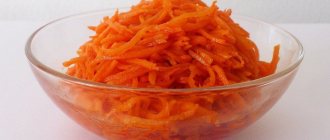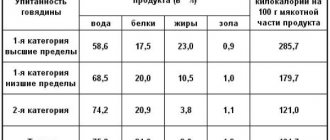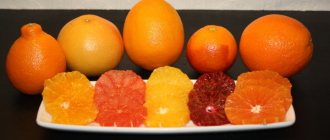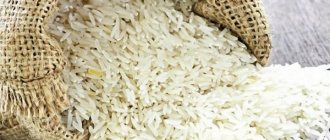Vegetable oil is made from sunflower seeds. The homeland of the plant itself is North America. During excavations, seeds were discovered that were two to three thousand years old. It is believed that the cultivation of sunflower began even earlier than the cultivation of wheat. The Indians made flour from the seeds, baked bread and used them for cosmetic purposes.
Peter I brought sunflowers to Russia after seeing the plant in Holland and becoming interested in it. At first, the sunflower served only a decorative function.
CALCULATORS FOR THOSE WHO WANT TO LOSE WEIGHT
The end of the 18th century, thanks to the research of Academician Severgin, changed the role of the plant, and sunflower seeds began to be used for oil extraction, making coffee and as bird feed. Full production began in 1829. D. Bokarev, being a serf, squeezed out two buckets using a manual butter churn.
Harm from vegetable oils
Vegetable oil, which has a higher calorie content even compared to lard, can cause irreparable harm to human health if consumed in excess. It also poses a danger when the original raw materials are genetically modified or treated with pesticides, which are used to manufacture a mass product.
To increase shelf life, industrial oils may contain a certain amount of artificial preservatives that are unsafe for the human body.
Healthy fatty acids have a very unstable structure and are easily oxidized under the influence of sunlight, oxygen and increased temperature. And oxidized fat can lead to inflammatory processes and mutations at the cellular level, causing various diseases.
During the refining and deodorizing process, the oil is treated with hexane, an organic solvent that can be considered analogous to regular gasoline. After separating the oil, the chemical compounds are washed off with water steam and alkaline solutions, and then bleached in a vacuum, but it is unlikely that they can be completely removed.
Therefore, partial residues of these compounds end up in the contents of the purchased bottle. Therefore, the consumption of refined oils, as well as industrial products containing them, should be kept to a minimum, or even better, completely excluded from the diet.
In addition, it is unacceptable to reheat used vegetable oil, as a result of which stable carcinogenic compounds are formed.
Types of sunflower oil
There are 3 methods used to extract sunflower oil all over the world:
1. Cold pressing - the raw materials are compressed, the resulting oil is bottled. More nutrients, taste and aroma of the seeds are preserved, but the shelf life is the shortest - 2-3 months.
2. Hot pressing - pre-roasted seeds are pressed, while the beneficial substances and taste are preserved, the shelf life is 2-3 months.
3. Extraction - the oil is extracted with special solvents that are passed through the raw materials, extracting the oil from it. The technology allows you to quickly and in large volumes produce the product, as well as extend its shelf life.
Sunflower oil, the benefits and harms of which depend on processing, are divided into types of purification carried out by:
- filtration;
- hydration (hot water cleaning is added to filtration);
- refining (deep processing);
- deodorization (hot dry steam treatment is added to refining);
- neutralization (after refining, impurities are removed using alkalis);
- freezing (wax and sediment are removed).
Oils can be of different types of processing; several others can be added to one purification, but it is necessarily divided into refined and unrefined.
Properties of refined oil
Refined oils are safe for frying and canning foods, they are purified, tasteless and odorless, do not contain sediment, and can be stored for more than a year.
Sunflower oil is used to produce edible fats and paints and varnishes. Used for the production of cosmetics (soap, cream) and medical products.
The refined product contains no vitamins, but fatty acids remain, thanks to which the oil effectively softens and moisturizes.
Features of unrefined oil
The unrefined cold-pressed product contains all the nutritional elements, the oil is fragrant, has a pleasant taste and aroma, ideal for salads, soups, vegetable dishes, cereals and marinades. Once opened, it can be stored in the refrigerator for 2 months.
You should not fry, stew or bake on it, it smokes and foams, the dish loses its taste, becoming saturated with a specific smell. In addition, heat treatment produces trans fats that are toxic to the body.
The components of unrefined oil contribute to the healing and rejuvenation of the entire body; the oil is actively used in the preparation of cosmetics.
Moreover, the amount of vitamin E in it is greater than in olive oil.
Cold press technology
Cold pressing involves pressing raw materials at low temperatures, while almost all nutritional elements are retained in the oil. If the inscription “cold pressed” is not on the packaging, it means that hot temperatures were used in production and the product has lost a significant amount of its beneficial properties.
Thanks to cold pressing, the oil is available for the preparation of most cosmetic recipes of traditional medicine. The product instantly hydrates and heals the skin, leaving it firm, soft and healthy.
Freezing oil
Freezing is used for both unrefined and refined oil. This clears the oil of wax impurities, which makes it clearer. The technology consists of slowly reducing the temperature to 10 degrees. After keeping the oil in it, raise the temperature to 20 degrees, while continuously stirring the oil. Next, the product is filtered.
Calorie content
Vegetable oil, the calorie content of which exceeds the energy value of all animal fats, can hardly be called a dietary product.
Vegetable oil, calorie content and composition.
| Product quantity | kcal |
| 100 g butter | 900 |
| 1 tablespoon | 107 |
| 1 teaspoon | 45 |
Content of proteins, fats, carbohydrates
The calorie content of different types of vegetable oils, as well as the nutrient content in their composition, may differ depending on the type. Basically, they all contain approximately the same amount of fat (from 90 to 100 g) with the complete absence of proteins and carbohydrates.
The only exception is chocolate cocoa bean butter, which contains per 100 g of product:
| Squirrels | 1.5 g |
| Fats | 62 g |
| Carbohydrates | 18.6 g |
| Calorie content | 642 kcal |
How to choose oil
Sunflower oil, the benefits and harms of which begin with the description on the packaging, must be selected by carefully reading the packaging:
- from what raw materials was the oil produced;
- date and place of issue;
- product storage requirements;
- quality certificates;
- marking the degree of purification;
- compound;
- terms of use.
When choosing, you need to pay attention to:
1. Transparency. For unrefined, a dark yellow color and a slight sediment are acceptable. Refined is characterized by transparency and the absence of sediment; if present, the product is spoiled.
2. Taste and aroma. Unrefined has a pronounced taste and smell of seeds. Refined has no taste or aroma. There should be no bitterness; if there is, the product is not edible.
3. Expiration date. The fresher the better.
4. Storage location. The place where the sunflower oil stands should be dark. If it is light, it is better to choose bottles from the depths of the shelf.
5. There should not be the inscription “vegetable oil”; if there is, the product contains impurities of other oils.
6. Refined oil does not contain vitamins, they are lost during cleaning and processing, so you need to choose one with vitamin supplements.
You can check the quality by dropping and rubbing the oil on the skin: if it is quickly absorbed, the quality is high.
It is advisable to purchase oil in small glass bottles or pour it into glass from plastic containers at home. Frequent opening will shorten the shelf life and reduce the usefulness of the product.
Daily requirement
Vegetable oil, the calorie content of which in the daily diet of an adult should not exceed 300 kcal, is sufficient to consume in an amount of no more than 2-3 tbsp. l. per day.
With such a reasonable distribution of healthy fats obtained from high-quality, unrefined, cold-pressed vegetable oil, a person will be able to maintain a normal weight and not violate the daily intake recommended by nutritionists. This amount fully covers the required intake of essential elements for the absorption of fat-soluble vitamins and does not cause harm to health.
You need to consume vegetable fats fresh, seasoning vegetable salads with them, then the body will be able to get the maximum benefit from them.
How many calories are in salads with vegetable oil?
Those who are losing weight are interested in how to choose a salad dressing with minimal fat content. The energy value of a vegetable salad without sauce is about 20 kcal, but if you add vegetable oil, the figure will increase by 35 kcal. This is even more than when using light mayonnaise.
Calorie content of salads when adding 1 tbsp. spoons of oil :
- from tomatoes ~ 170 kcal;
- from cabbage ~ 180 kcal;
- from carrots ~ 190 kcal;
- from cucumbers ~ 165 kcal;
- vinaigrette ~ 190 kcal;
- Greek ~ 205 kcal.
To get the maximum benefit from eating vegetable salads with dressing, you should choose only fresh, high-quality products. To enhance the taste of the snack, you can add a little garlic and mustard oil (890 kcal). How the calorie content of sour cream affects the value of salads can be read in our article.
Glycemic index
The value of the glycemic index of a product shows the time and rate of increase in blood glucose levels after its entry and breakdown into the human body. This factor is especially important for diabetics, who must monitor the amount of insulin.
The glycemic index of vegetable oils is 0; for comparison, this indicator in butter is 51. Therefore, for diabetes and obesity, it is necessary to limit the amount of animal fats as much as possible, replacing them with high-quality vegetable oils.
Changes in the beneficial properties of oil during heat treatment
At the smoking point, substances harmful to the human body are formed in vegetable oil:
- acrylic acid aldehydes cause lacrimation, and have a strong irritating effect on the mucous membrane of the organs of vision and breathing, accumulate in the body;
- amides of the same acrylic acid cause damage to the nervous system and liver cells, especially a lot of them are formed when frying starch-containing products;
- toxic substances in the form of free radicals, heterocyclic amines and polymers formed as a result of combustion and smoke cause danger already at the stage of inhalation, as well as upon contact with the skin.
| Type of vegetable oil | Smoke point, °C |
| from avocado | 270 |
| mustard | 250 |
| from soy | 234 |
| olive refined | from 190 to 240 |
| corn refined | 231 |
| made from peanuts | 229 |
| sunflower refined | 227 |
| corn | 178 |
| sesame | 177 |
| sunflower | 160 |
| linen | 107 |
Do not overuse fried foods, cook in hot oil, or overheat dishes. It is necessary to fry using foods with a high smoke point, choosing refined fats, and using oil only once. Do not cook over high heat for too long, as overcooking foods leads to the formation of more harmful substances in their composition.
Under the influence of sunlight and time, oxidation processes occur in the oil, which cause the product to go rancid, making it unfit for consumption. This happens very often and quite quickly with pumpkin seed oil, which begins to spoil at room temperature within a few hours.
Any oil must be stored correctly; it is advisable to use a dark glass bottle, placing it in a dark and cool place.
Value of other oils
All vegetable oils have a beneficial effect on many systems and processes in the body. Peanut (899 kcal) makes eyelashes, nails and hair healthier and more well-groomed, hemp (899 kcal) improves skin condition, and flaxseed (898 kcal) enhances brain activity.
Oils with a value of 899 kcal are often used in cooking:
- coconut,
- Palm,
- soybean,
- sesame,
- corn.
It is advisable to avoid frequent consumption of dishes with palm oil due to the fact that it is difficult to digest by the digestive system and gradually destroys the immune system.
If you introduce various oils into your diet, you will soon notice a noticeable improvement in hair structure and skin condition, and an increase in performance. With proper use of the product, you can maintain a slim figure.
How to use vegetable oils on a diet?
Nutritionists in many diets strictly regulate the intake of healthy vegetable fats to the minimum allowable amount of 1-2 tbsp. l. per day, which will lead to gentle and stable weight loss in natural conditions for the body.
While on a diet, it is necessary to include unrefined vegetable fats in your daily diet; nutritionists especially recommend that you pay attention to cold-pressed almond, apricot, olive or sesame oil, which are ideal for dressing salads or making sauces.
Flaxseed oil in moderation also has a beneficial effect on the process of weight loss, due to lipid metabolism and accelerating metabolism.
Castor oil helps in the fight against excess body weight due to its cleansing properties and removal of toxins from the body. It is even recommended to use it in a 10-day course on an empty stomach in the morning, which leads to normalization of stools and regular bowel emptying.
Milk thistle oil helps reduce blood glucose levels, speeds up metabolic processes and promotes weight loss. But even the highest quality oil will not lead to weight loss without proper nutrition and the necessary physical activity.
Vegetable oil is a high-calorie product with a lot of useful substances. It has a number of significant restrictions on use, so it is worth using it in the daily diet in limited quantities, taking the necessary precautions to select and use only high-quality fats in food.
The harm of omega-6 fats
Any types of sunflower, soybean and corn oils (both refined and unrefined) consist of 60-80% omega-6. Despite the fact that this substance itself is not harmful to health, its excess in the daily diet upsets the balance of metabolism - increasing the need for omega-3.
The consequences of imbalance are microinflammation in the body and disruption of cell regeneration processes². The situation is aggravated if a person does not consume salmon, salmon, fish oil or other sources of omega-3. Note that a lack of omega-3 in the diet is a fairly typical problem.
// Omega-3 and fish oil are normal
Olive oil
Olive oil consists primarily of omega-9 monounsaturated fatty acids, which are neutral to health and do not affect the balance of omega-6 and omega-3. Canola oil has a similar composition - it is usually refined before going on sale, allowing it to fry without smell.
On the other hand, adding a small amount of olive oil to vegetable oil does not fundamentally change the situation. Unfortunately, the olive oil content in such mixtures is usually no more than 5-10% - in other words, this is ordinary sunflower or corn oil.
// Read more:
- Is it possible to fry in olive oil?
- Canola oil - what is it?
***
New Fitseven materials, 5 times a week - in telegram:
- fit7seven
Vegetable oil is a product obtained from vegetable raw materials and containing triglycerides. The main types are sunflower, olive, soybean, corn, rapeseed, palm and coconut. Cold-pressed olive oil is considered the most beneficial.
Scientific sources:
- Reduction in saturated fat intake for cardiovascular disease, source
- Health implications of high dietary omega-6 polyunsaturated Fatty acids, source











